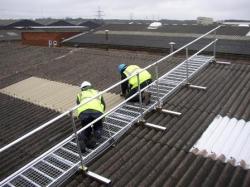The hidden danger of skylights
 The hidden danger of skylights
The hidden danger of skylights
Falls from height are one of the largest workplace killers in the UK, thanks to the inherent danger of working at height, as well as the sometimes ambiguous requirements and responsibilities of those who carry out the work.
One of the biggest contributors to work at height injury and death statistics are unprotected skylights and rooflights. Many people often assume skylights are safe, going on the idea that builders and designers wouldn’t in their right minds install something which would not prevent a fall.
Though skylights are required to be ‘man-safe’ when installed, weather and UV damage can quickly affect the skylight’s protective layers, rendering it brittle and unsafe. Even more concerning is the fact that some older-style rooflights can actually become discoloured and blend in with the roof, making them effectively invisible.
Falls through rooflights are the cause of nearly a fifth of all fatal working at height accidents.
Though it is very important to ensure skylights and rooflights are protected and squared away, many are not, leaving them open and putting those who access the roof - both officially and illegally - at risk of serious injury or death. The most common reason for skylights being left unprotected is, perhaps predictably, cost and effort.
Case study
An 18-year-old male sheet metal helper died after he fell through a skylight opening to a concrete floor 33 feet below. The victim was working as a member of a crew engaged in replacing corrugated metal roof sheeting and installing chain-link fencing material on top of fiberglass panels used as skylights.
The fencing material was being installed to eliminate the hazard of falls posed by the fiberglass skylights, as three months earlier a worker on the same site had fallen to his death through one of them. When the supervisor ordered the crew to stop work temporarily, the members of the crew moved toward a vent stack to warm themselves. As they moved, the victim stepped on one of the unguarded skylights and fell through it. He died at the hospital two hours later.
Solutions
There are a few options available to reduce the risk skylights and rooflights pose. The first is by far the simplest: avoid going onto the roof to do work wherever possible. The work at height hierarchy of controls prioritises this over all other forms of protection.
When it comes specifically to the skylight, keep in mind that sheets and skylights can often be replaced from underneath using a mobile elevating work platform (MEWP) or a tower scaffold.
As a solution to the problem of fragile skylights and roofs, Easi-Dec offers the Board-Walk system, a lightweight aluminium walkway allowing access from eaves to ridge whilst spreading the load on support battens, providing the user with a safer working position.
Providing full visibility and great for all weather use, the Board-Walk system makes accessing a roof with rooflights simple and safe.
Further options, such as skylight guardrail protection and temporary weighted anchor points are available for contractors who have to access different roof locations on a limited basis.
Finally, training, as always, is a vital part of keeping yourself safe when working at height. Competent workers should be trained to recognise and avoid the dangers of skylights and rooflights, so even if the correct protection is missing, there is less chance that serious injury - or worse - will occur.
For more information about skylight safety or to find out about the solutions Easi-Dec offers, call our product experts on 01767 691812 or use our contact form.